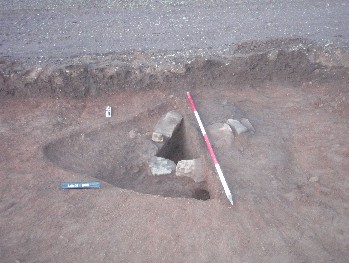Lanton Quarry
Iron Age (700 BC- AD 70):
The Iron Age broadly correlates with the period spanning the introduction of iron in the early first millennium BC and the arrival of the Romans in the area around AD70.
During the second phase of the excavations two stone-built grave boxes built into pits dug into the gravel and known as 'cists' were discovered in the southern part of the site. Cists are stone-lined burial chambers that are most typical of the Beaker period and Early Bronze Age. They usually consist of flat slabs of stone that form a box shape in which the deceased person is placed. Often ceramic vessels are placed in the grave with the person before another stone slab is placed over to seal it. At Lanton Quarry, however, the cists were not constructed from flat slabs. Instead they had been built with smaller stones, almost like bricks, to produce a corbelled chamber. One cist still had the capstones that originally covered it indicating that it had not previously been disturbed.
This cist was found to contain human remains although they were not the complete skeleton. The skull and leg bones of a female were discovered on the base of the cist with the skull having been placed on a stone 'pillow'. After specialist analysis we now know that she would have been around 70 years of age when she died. Radiocarbon dating has also told us that the woman would have been alive during the Iron Age period, around 50BC. At this time it was quite rare for people to reach such an old age. Analysis of the bones shows us that the woman was suffering from a joint disease, probably arthritis, which is not surprising for a woman of this age. Otherwise the lack of evidence for disease, combined with the fact that she had such a carefully constructed grave, may indicate that she was a woman of high status amongst her community. Could this woman have been royalty, or perhaps even a female druid? Druids were the highly learned and wise folk who were the renowned teachers, judges and religious leaders of British society.
The initial exposure of the cist in which the Iron Age woman had been buried |
The cist after excavation showing the human remains |
A closer look at the woman's skull |
| Neolithic | Bronze Age | Medieval |



